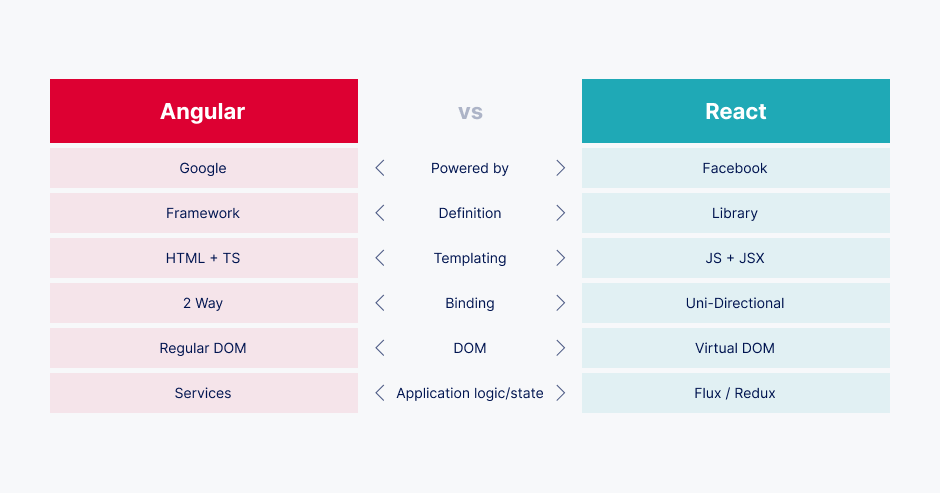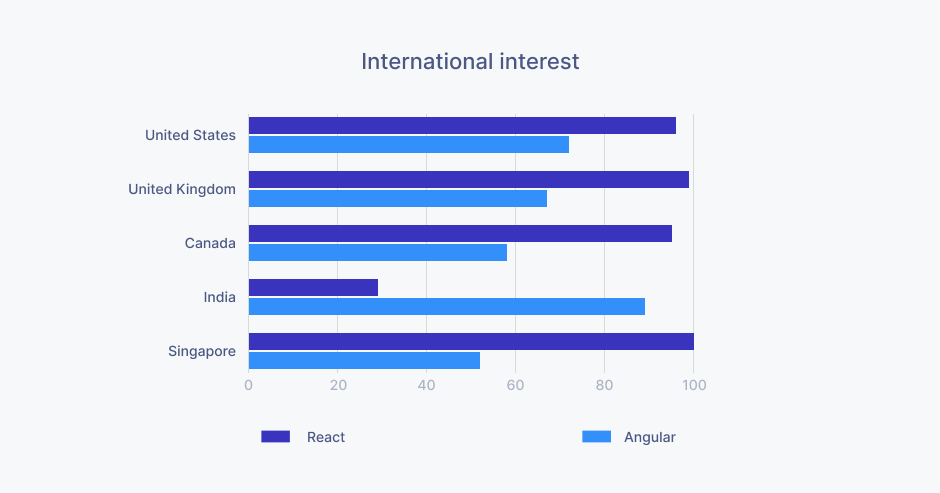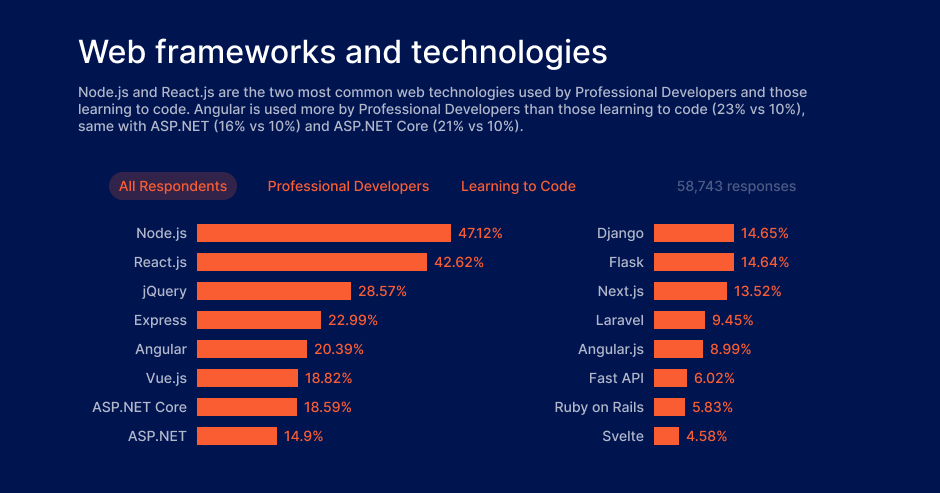Trying to decide between Angular and React for your web or mobile app development? It's a common question in the ever-changing world of front-end web development.
On one side, there's Angular—a robust application design framework by Google, powering Gmail, YouTube TV, and Udacity. On the other side, there's React—a high-performance UI library from Facebook, used in applications like Instagram, Facebook, and Netflix.

Explore the key differences between these technologies to discover the best fit for your project. Keep reading to make an informed choice!
Also read: JavaScript developer hiring guide
What is Angular?
Angular, initially released in 2010 as AngularJS and later rebranded as Angular in 2016 with the introduction of Angular 2, is a popular open-source web application framework developed by Google. Angular is known for its robustness and flexibility, providing developers with a comprehensive set of tools and features to build complex and scalable web applications.
At the core of Angular lies its component-based architecture, which promotes modularity and reusability, making it easier to manage and maintain large applications. Two-way data binding is another key feature of Angular, enabling seamless synchronization between the view and the underlying data model. This capability reduces the amount of boilerplate code developers need to write, resulting in cleaner and more maintainable codebases.
Angular also offers dependency injection, a technique that allows for the automatic resolution of dependencies between different parts of the application. This feature enhances testability and maintainability while fostering a clear separation of concerns. Moreover, Angular boasts strong community support, with a vast ecosystem of third-party libraries and resources available to developers.
What is React?
React, introduced in 2013 by Facebook, is an open-source JavaScript library designed for building user interfaces. The core idea behind React is to break down complex UIs into smaller, reusable components, making development and maintenance more manageable. React has gained immense popularity due to its high performance and flexibility, as well as its large ecosystem and community support.
One of the key features of React is the Virtual DOM, which is an in-memory representation of the actual DOM. This technology allows React to efficiently update the UI by only rendering the components that have changed, resulting in faster performance and smoother user experiences. React also employs one-way data binding, which enforces a unidirectional flow of data, making it easier to reason about the application's state and reducing the likelihood of unexpected side effects.
React's component-based architecture, similar to Angular, promotes modularity and reusability, simplifying the process of building and maintaining large applications. The vast ecosystem of third-party libraries and tools available for React developers further enhances the flexibility and capabilities of the library.
Also read: Hiring a React developer: Skills, roles & opportunities in remote teams

Angular vs. React: A Quick Comparison
In this section, we will provide a brief comparison of Angular and React across various aspects, including popularity, performance, data binding, code quality, server-side rendering, testing, bundle size optimization, and learning curve.
- Popularity: Both Angular and React enjoy immense popularity and strong community support, with numerous resources, tutorials, and third-party libraries available to developers. While Angular is a full-fledged framework backed by Google, React is a flexible library supported by Facebook. The choice between the two may depend on factors such as project requirements, team expertise, and personal preferences.
- Performance: When it comes to performance, React is known for its fast rendering capabilities, thanks to the Virtual DOM. On the other hand, Angular's two-way data binding can sometimes impact performance negatively in large-scale applications. However, Angular offers built-in optimization tools and techniques to mitigate these issues.
- Data binding: Data binding in Angular is two-way, ensuring seamless synchronization between the view and the model. React employs one-way data binding, promoting a unidirectional flow of data, making it easier to manage the application state.
- Code quality: In terms of code quality and maintainability, both frameworks promote the use of a component-based architecture, resulting in modular and reusable code. Angular's strict structure and conventions may make it easier to enforce coding standards, while React's flexibility allows for more customization and adaptability.
- Server-side rendering: Server-side rendering is well-supported in both Angular and React. Angular has the built-in Angular Universal platform, and React offers the popular Next.js framework for server-side rendering and static site generation.
- Testing: Testing is an integral part of both frameworks, with Angular providing a comprehensive testing framework and a variety of testing tools, while React offers Jest, Enzyme, and React Testing Library for efficient unit and integration testing.
- Bundle size optimization: Bundle size optimization is crucial for improving application performance. Angular has built-in tools to optimize bundle size, while React developers can leverage third-party libraries and tools such as Webpack to manage and optimize their bundles.
- Learning curve: learning curve for Angular is generally steeper than React due to its more complex structure and concepts. React, being a library, is easier to pick up, especially for developers familiar with JavaScript. However, both frameworks have extensive documentation and resources available to help new learners.
Also read: C++ vs Rust: Is C++ being replaced by Rust
When to Choose Angular
Angular might be the right choice for your project if you are working on a large-scale application that requires a structured and organized codebase. In such cases, Angular's strict conventions and full-fledged framework features can be beneficial in managing complex projects and ensuring maintainability.
Angular's comprehensive toolset, built-in features, and strong community support make it an attractive choice for developers who prefer a full-fledged framework over a more flexible library like React. With Angular, developers can access a wide range of tools and resources that help streamline the development process and improve overall application quality.
In conclusion, if you are building a large-scale application and prefer a structured, full-featured framework, Angular might be the right choice for your project. However, it is crucial to evaluate both Angular and React based on your specific project requirements, team expertise, and personal preferences to make the best decision.
Get matched with senior vetted Angular developers vetted for remote performance, tech expertise and soft skills. Get started now →
When to Choose React
React might be the ideal choice for your project if you require a dynamic and high-performance application. The Virtual DOM in React enables efficient rendering, providing a smooth user experience and faster performance. React's flexibility in choosing libraries and tools makes it an attractive option for developers who prefer customization over a strict framework like Angular. This adaptability allows you to tailor your development stack to your specific needs, ensuring the best fit for your project.
Another factor to consider when deciding between React and Angular is your preference for a library rather than a full framework. React's focus on being a library for building user interfaces makes it easier to learn and integrate with other libraries and tools. This approach can be more appealing to developers who want to build custom solutions without the constraints of a full-fledged framework.
In summary, if your project demands a dynamic, high-performance application with the flexibility to choose libraries and tools, React might be the right choice. Keep in mind that the final decision should be based on your project requirements, team expertise, and personal preferences, ensuring a successful outcome.
Get matched with senior vetted React developers vetted for remote performance, tech expertise and soft skills. Get started now →

React vs. Angular: Commonalities
Despite their differences, React and Angular share several common features that make them both popular choices for frontend development. Understanding these commonalities can help developers make more informed decisions when choosing between the two frameworks.
First and foremost, both React and Angular are built on a component-based architecture, which promotes modularity and reusability in application development. This approach helps break down complex UIs into smaller, manageable components, making it easier to develop and maintain large applications.
Another similarity between React and Angular is the strong community support they receive. Both frameworks have large, active communities of developers who contribute to their respective ecosystems, providing resources, tutorials, and third-party libraries. This support ensures that developers have access to a wealth of information and tools when working with either framework.
Finally, both React and Angular see frequent updates and improvements from their parent companies (Facebook and Google, respectively). These updates ensure that the frameworks remain relevant, secure, and optimized for performance, providing developers with the best possible tools for building modern web applications.
Also read: 6 strategies for seamless integration of remote developers into your tech team
How Index.dev Can Help with Your Project
Choosing the right frontend framework for your project is just one part of the equation. To ensure the success of your software development project, you need a team of skilled developers who can efficiently utilize the chosen framework.
Also read: 15 less-known benefits of hiring contractors with Index.dev
Index.dev can provide invaluable support for your project by offering:
- Access to top software engineers worldwide: With Index.dev, you can tap into a global pool of experienced and talented software engineers, allowing you to build a team that meets your project's specific requirements.
- Simplified team scaling and management: Index.dev streamlines the process of scaling remote software teams by providing a centralized platform for talent matching, team management, and payroll services.
- Streamlined payroll and compliance processes: Managing payroll and compliance for a remote team can be challenging. Index.dev simplifies this process, allowing you to focus on your project while handling the administrative tasks.
- Curated network of experienced developers: The platform ensures that only the most qualified and suitable candidates are matched with your project, ensuring the highest quality and performance.